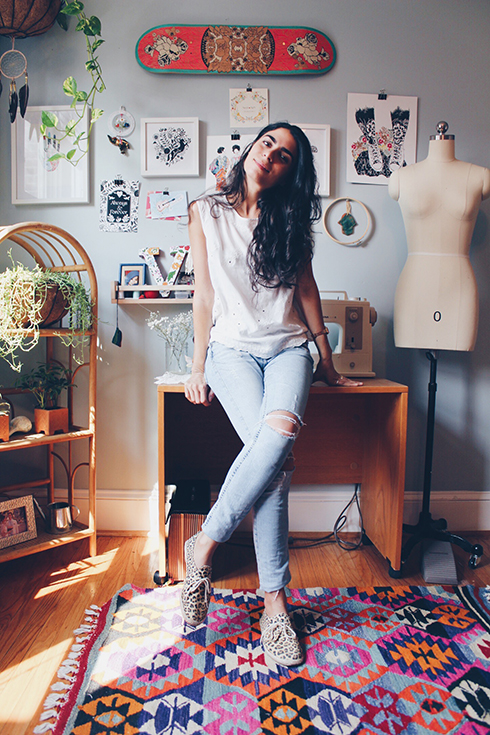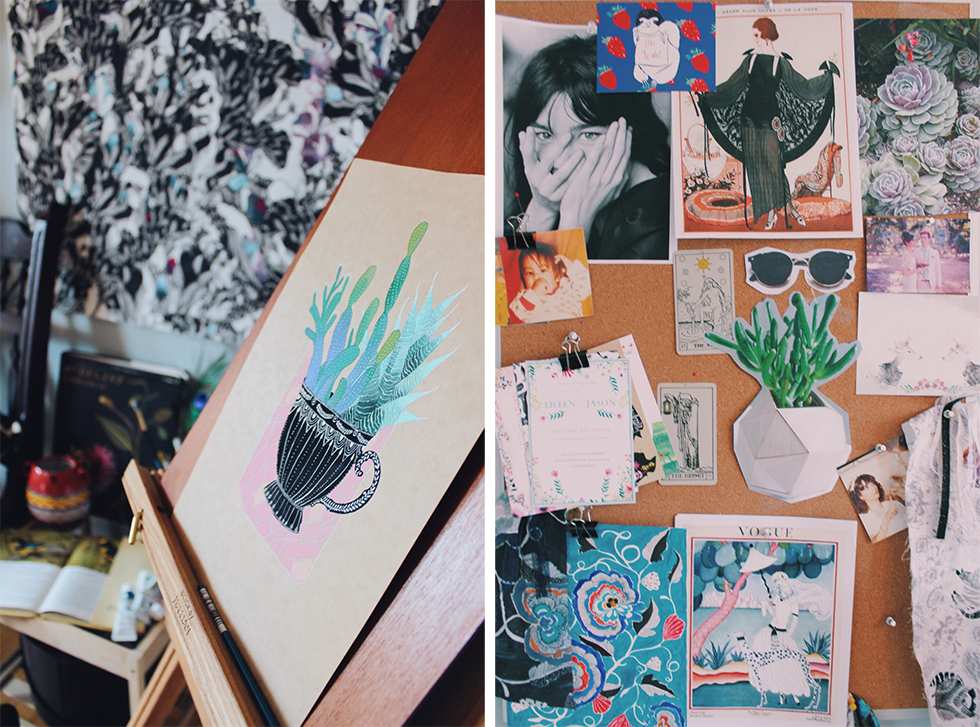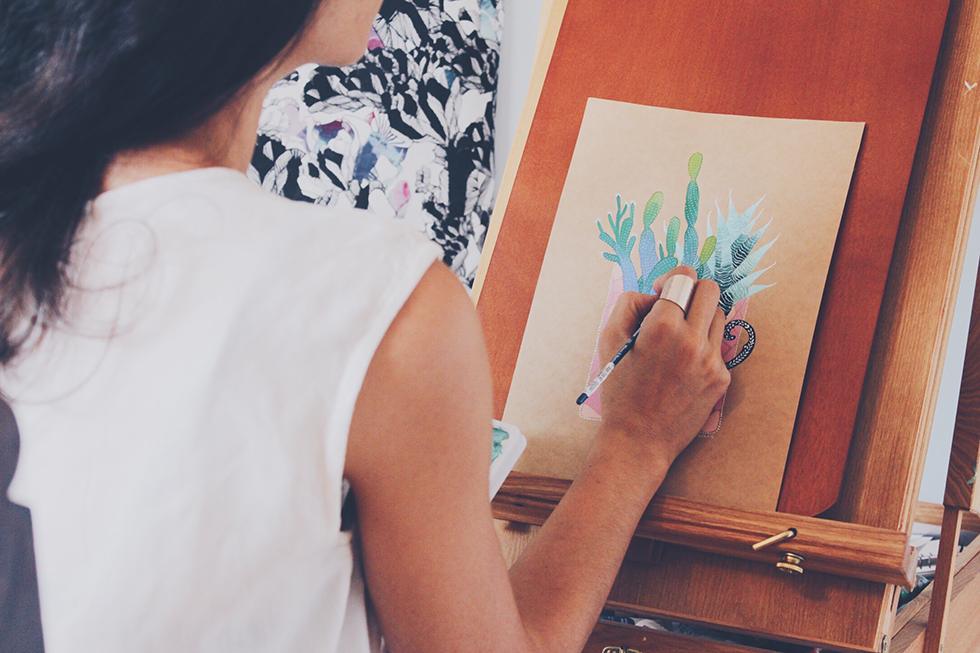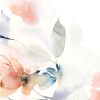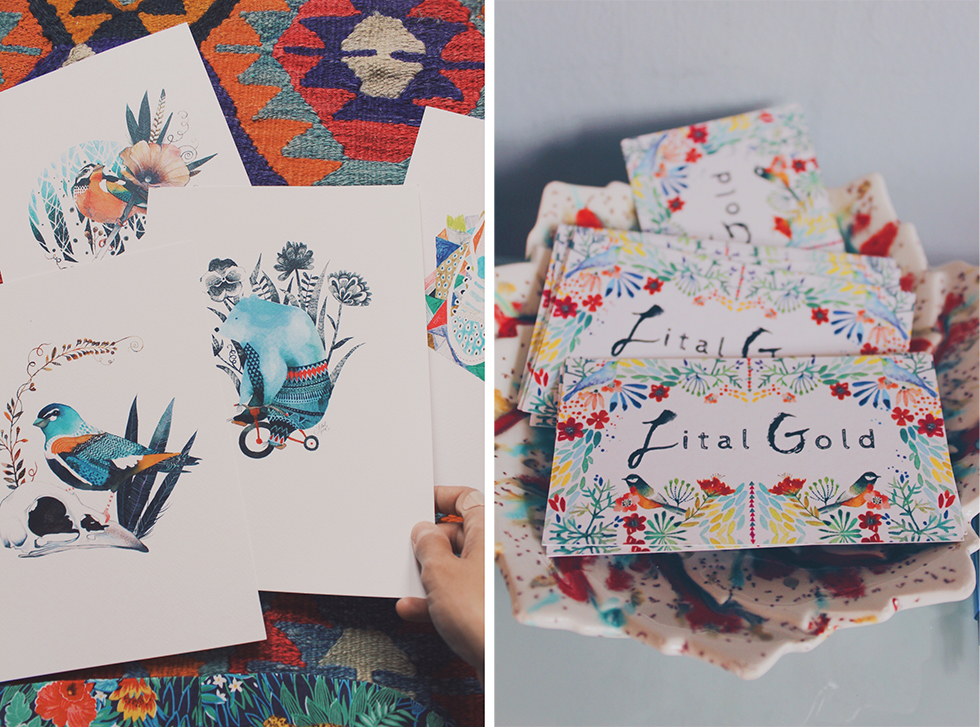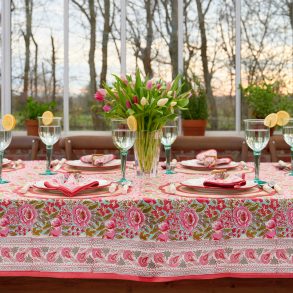Lital Gold is a textile designer and artist originally from Israel, who moved to Philadelphia in 2011 to work as part of the print-and-color team for Free People. (You may remember Lital from past features here, here and here.)
Lital is joining us this month as our guest expert for the Textile Design Lab, and later this month will be offering an exclusive tutorial to Lab members on different techniques for creating hand-painted artworks, and will also be touching on trend interpretation. Stay tuned as we will be sharing a small excerpt of this training on Pattern Observer!
Today, you can learn more about Lital in this inspiring interview–enjoy!
Tell us a bit about your design background/career path. How did you become interested in textile design?
I was born and raised in Israel. As a kid, I used to spend time at my dad’s studio (he is a graphic designer). I was always drawn to the art books, catalogs and design magazines that he had in his library. He had exciting things in his studio, like a Pantone fan and boxes filled with colors, paints and different kinds of papers; it was like heaven for me. I used to sit there all day during summer break and draw with him. This is where my love for painting came from. Watching my dad really inspired me to have a design studio when I grow up and that’s exactly what happened. I went to Art high school and majored in visual art and when it was time to go to college, I was very curious about textile design. I was looking to study something creative that contains a little bit of everything-art, fashion, graphic design and pattern design. I wanted to keep painting, but put the skill into something more practical and this is how I found textile design. After graduating, I had two different options. I got accepted to an internship at DVF in NYC but was also offered a job at the Free People studio in Philadelphia. I chose Philly and this is how I came to the USA. These days I work from my studio, collaborating with different brands and working as a print/cad designer. I also work on my own line of clothing that will be launched in spring 2016.
You have a very recognizable style to your work–is this something that developed naturally or did you have to make a conscious effort to create a cohesive body of work?
It’s kind of a never ending process. I think it’s a little bit of both- everyone has their own natural style, creative process and visual aesthetic. The vision needs to be as clear as possible and then to always develop. When it starts to develop, the body of work starts to grow naturally. How do you find your style? Being in school helps because you are in kind of a free mind set and you can ask questions and wonder and try new things. Another part of it is also to find a technique that feels good for you and makes you feel comfortable enough to go ahead and develop. The biggest thing is to find something in it that you can make yours. It’s not really about inventing something, it’s more like creating a unique style and telling a new story.
A cohesive body of work comes naturally as soon as there’s an excitement. All you want to do is to sit and work more and more. And, though there’s always room for fears or questions, the path is clear.
Since you have worked both as a part of the print-and-color team for Free People and also as a freelance illustrator and surface designer, could you talk about the differences between working in-house and freelancing? What should designers know when considering these two tracks? What do you enjoy most about each, and what are some of the challenges?
Being an independent designer is fundamentally different than working full time in a studio and it has its own benefits and drawbacks. When you freelance, you need to keep in mind that it’s all “on you” for the good and bad. It’s not as dramatic as it sounds, but it’s true that you have to work twice as hard in order to find work, and consider many different things that now have bigger meaning like, structuring your day and having daily routines and while keeping in mind that sometimes there’s work and sometimes there’s less. In full time, the structure is very defined and you know exactly what you need to do and in what time frame.
What I like about working independently is the challenge and the risk. It teaches me a lot about myself. It also gives me freedom to structure my day the way I want, work for different industries with my own rates and to really create ‘surface design’-which means to work in different channels and not just with one. I also have time to develop my style and art and work on my line.
What I love about working full time is the people. I love to work with people, to hear more opinions and just to connect and make friends. It is so necessary for the creative process. It’s also a great opportunity to be in a supportive environment and learn the industry from the inside. I loved working full time but at some point I decided to try something new and take a chance and I’m glad I did because I’ve learned so much. I’d recommend to try full time first, especially if you are just starting to build your professional career. It will give you some time to learn the industry, get some experience managing yourself and develop/know your work habits before going for a freelance career.
Tell us a bit about your design process. What media/design tools do you like to use?
I usually start from collecting some inspiration according to the trend I’m working on. After I have a good amount of inspiration (pictures, prints, fabric swatches, trims etc) I start to paint. I use watercolor and inks because those are my favorite mediums. Depending on what I want to achieve, however, I would also use pencils, gouache, stencils, pastels and whatever fits the project. The type of fabric also matters because the print, colors and overall feeling should match it.
I draw in my sketchbook but also like to use bigger blocks of paper for bigger elements with more details. I scan the painting anywhere between 300-600 dpi and work on 200-300 dpi in RGB. I mostly use Photoshop and work with a drawing tablet (Wacom). It’s perfect for Cadding/ painting and building repeats on the computer. I keep all of my layers (unless there are too many) in a separated group. This way I can always go back and reevaluate the work.
After scanning the paintings, I build the print according to the design brief–repeat/half drop/placement, keeping in mind color palette and numbers of screens.
As I said, my favorite media is watercolor and inks and what I love about them is that there are many different options and different associated feelings. All of the emotions are already in the paint: All you need to do is shape them!
What role do trends play in your design process? Do you subscribe to any trend or color forecasting services and if so, how does this affect the way you design? What are your current favorite print and pattern trends?
I recently read an article that said that some will say that trend is a thing to follow/predict and some might say that trends don’t really exists, it’s only a question of aesthetic. I’m not sure what I feel about it, I still find truth in both.
I used to have a subscription to WGSN through my job and it was very helpful, especially for color palettes and images. These days, and actually since I’ve graduated, I’ve checked out Lidewij Edelkort’s blog, TrendTablet. I’ve been to a few of Lee’s lectures and I read her articles and watch her interviews, she is an inspiring woman but also has an incredible eye and theory for trends and styles that I can really relate to. Trends give the designer the structure, the frame in which they work in. In this frame-there’s no limit. It’s like playing a game.
Who are your design heroes? What about them inspires you or influences your work?
There are a lot of designers/artists that inspire me and my work a lot, though I think the biggest and most important one for me is Iris Apfel. She speaks what’s in my heart.
The first time I heard her name was in school in trend class, but I got to know some more about her since I came to the USA. I watched the documentary film about her recently (highly recommend!!) and it changed my perspective in so many ways. There are too many things about her that inspire me. I absolutely adore her style, I love the way she sees patterns and the way she uses them, not to mention the way she wears them. The way she treats colors is poetic and it inspires me a lot, the thing that got me the most in the movie was when she said “color can raise the dead”.
She has no fear, but only pure truth that she follows without making a huge deal from herself. Her thinking is simple and yet very detailed and different, like there are no rules. She believes you shouldn’t be scared to be or to think like everyone else does. It’s so unique. She makes me see what pattern and print design truly is and this perspective inspires me everyday. And of course she is a super sweet lady!
Over the course of your career, what actions or decisions have made the biggest impact on your design business?
Every situation where I have had to take a risk turned out to have a big impact on my career and mind/eye opening, I’m very thankful for everything that I’ve learned and still learning everyday. I think the first one was to come to the USA. It’s hard to describe in words how much I’ve learned from moving here and living here and working in the industry. The second one was to work independently from my studio, this is what I’ve always wanted and even though it’s not always easy, I love it.
Recently, I started taking some business managing sessions that really help me to understand another side of the industry that is equally important if you want to grow as a designer. Eventually, I would like to have my own line of products and it’s important to learn what they don’t always teach you what you need to know in design school. It’s a challenge for me because I’m not very good with numbers, but this was a big step and a good start for me. Traveling also helps me and I remember when I first visited India, I knew I wanted to study textile and print design. It opened my mind.
What advice have you received in your career that has stayed with you or influenced you? Do you have any words of advice for aspiring designers trying to make their way in the textile industry?
One bit of advice that is always in my heart came from my dad, the night I decided to take the FP position and come to Philadelphia. He told me exactly what I needed to hear in that moment, and it was that fear is a choice. I can choose to be scared of something and not to take a chance, stay in my comfort zone and never know what it might have led to. Or, I can give it a try and be brave, and that there’s always a way back. He also told me that it’s very important to have questions, doubts and mistakes along the way because that is how you learn and climb higher. His words motivate me everyday.
This is also my advice for all the designers out there that are trying to make it in the industry. Always remember to see the potential, and to not be scared and to believe in themselves no matter what.
You can visit Lital online at http://www.litalgold.com/, or check out her Etsy shop, Facebook page or her inspiring Instagram feed.
Become a Textile Design Lab member to gain access to Lital’s full tutorial on hand-painted techniques and all of our past guest expert tutorials and the other wonderful e-courses and features of the Lab. Visit textiledesignlab.com to learn more!


